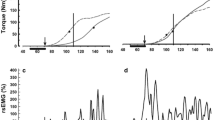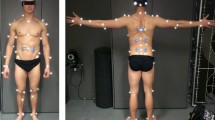Abstract
Paraspinal muscle fatigability during various trunk extension tests has been widely investigated by electromyography (EMG), and its task-dependency is established recently. Hip extensor muscle fatigability during the Sorensen test has been reported. The aim of the present experiments was to evaluate the task-dependency of back and hip extensor muscle fatigue during two variants of the Sorensen test. We hypothesized that the rate of muscular fatigue of the hip and back extensor muscles varies according to the test position. Twenty healthy young males with no history of low back pain volunteered to participate in this cross-sectional study. They were asked to perform two body weight-dependent isometric back extension tests (S1 = Sorensen test; S2 = modified Sorensen on a 45° Roman chair). Surface EMG activity of the paraspinal muscles (T10 and L5 levels) and hip extensor muscles (gluteus maximus; biceps femoris) was recorded, and muscular fatigue was assessed through power spectral analysis of the EMG data by calculating the rate of median power frequency change. We observed hip extensor muscle fatigue simultaneously with paraspinal muscle fatigue during both Sorensen variants. However, only L5 level EMG fatigue indices showed a task-dependency effect between S1 and S2. Hip extensor muscles appear to contribute to load sharing of the upper body mass during both Sorensen variants, but to a different extent because L5 level fatigue differs between the Sorensen variants. Our findings suggest that task-dependency has to be considered when EMG variables are compared between two types of lumbar muscle-fatiguing tasks.





Similar content being viewed by others
References
Arendt-Nielsen L, Gantchev N, Sinkjaer T (1992) The influence of muscle length on muscle fibre conduction velocity and development of muscle fatigue. Electroencephalogr Clin Neurophysiol 85:166–172. doi:10.1016/0168-5597(92)90128-X
Clark BC, Manini TM, Mayer JM, Ploutz-Snyder LL, Graves JE (2002) Electromyographic activity of the lumbar and hip extensors during dynamic trunk extension exercise. Arch Phys Med Rehabil 83:1547–1552. doi:10.1053/apmr.2002.34828
Coorevits PLM, Danneels LA, Ramon H, Van Audekercke R, Cambier DC, Vanderstraeten GG (2005) Statistical modelling of fatigue-related electromyographic median frequency characteristics of back and hip muscles during a standardized isometric back extension test. J Electromyogr Kinesiol 15:444–451. doi:10.1016/j.jelekin.2005.02.002
CSST (2006) Statistiques sur les affections vertébrales 2002–2005 éd: Commission de la santé et de la sécurité au travail
Da Silva RA, Arsenault AB, Gravel D, Larivière C, de Oliveira E (2005) Back muscle strength and fatigue in healthy and chronic low back pain subjects: a comparative study of 3 assessment protocols. Arch Phys Med Rehabil 86:722–729. doi:10.1016/j.apmr.2005.03.034
De Luca CJ (1993) Use of the surface EMG signal for performance evaluation of back muscles. Muscle Nerve 16:210–216. doi:10.1002/mus.880160216
De Luca CJ (1997) The use of surface electromyography in biomechanics. J Appl Biomech 13:135–163
Dedering Å, Németh G, Harms-Ringdahl K (1999) Correlation between electromyographic spectral changes and subjective assessment of lumbar muscle fatigue in subjects without pain from the lower back. Clin Biomech (Bristol, Avon) 14:103–111. doi:10.1016/S0268-0033(98)00053-9
Donner A, Eliasziw M (1987) Sample size requirements for reliability studies. Stat Med 6:441–448. doi:10.1002/sim.4780060404
Elfving B, Dedering A (2007) Task dependency in back muscle fatigue—correlations between two test methods. Clin Biomech (Bristol, Avon) 22:28–33. doi:10.1016/j.clinbiomech.2006.08.007
Elfving B, Dedering A, Németh G (2003) Lumbar muscle fatigue and recovery in patients with long-term low-back trouble—electromyography and health-related factors. Clin Biomech (Bristol, Avon) 18:619–630. doi:10.1016/S0268-0033(03)00095-0
Farina D, Gazzoni M, Merletti R (2003) Assessment of low back muscle fatigue by surface EMG signal analysis: methodological aspects. J Electromyogr Kinesiol 13:319–332. doi:10.1016/S1050-6411(03)00040-3
Kankaanpää M, Laaksonen D, Taimela S, Kokko SM, Airaksinen O, Hänninen O (1998) Age, sex, and body mass index as determinants of back and hip extensor fatigue in the isometric Sørensen back endurance test. Arch Phys Med Rehabil 79:1069–1075. doi:10.1016/S0003-9993(98)90173-3
Kankaanpää M, Taimela S, Laaksonen D, Hänninen O, Airaksinen O (1998) Back and hip extensor fatigability in chronic low back pain patients and controls. Arch Phys Med Rehabil 79:412–417. doi:10.1016/S0003-9993(98)90142-3
Koumantakis GA, Arnall F, Cooper RG, Oldham JA (2001) Paraspinal muscle EMG fatigue testing with two methods in healthy volunteers. Reliability in the context of clinical applications. Clin Biomech (Bristol, Avon) 16:263–266. doi:10.1016/S0268-0033(00)00113-3
Kramer M, Ebert V, Kinzl L, Dehner C, Elbel M, Hartwig E (2005) Surface electromyography of the paravertebral muscles in patients with chronic low back pain. Arch Phys Med Rehabil 86:31–36. doi:10.1016/j.apmr.2004.01.016
Lariviere C, Arsenault AB, Gravel D, Gagnon D, Loisel P (2003) Surface electromyography assessment of back muscle intrinsic properties. J Electromyogr Kinesiol 13:305–318. doi:10.1016/S1050-6411(03)00039-7
Larivière C, Arsenault AB, Gravel D, Gagnon D, Loisel P, Vadeboncoeur R (2002) Electromyographic assessment of back muscle weakness and muscle composition: reliability and validity issues. Arch Phys Med Rehabil 83:1206–1214. doi:10.1053/apmr.2002.34558
Latimer J, Maher CG, Refshauge K, Colaco I (1999) The reliability and validity of the Biering-Sorensen test in asymptomatic subjects and subjects reporting current or previous nonspecific low back pain. Spine 24:2085–2089. doi:10.1097/00007632-199910150-00004
Leinonen V, Kankaanpää M, Airaksinen O, Hänninen O (2000) Back and hip extensor activities during trunk flexion/extension: effects of low back pain and rehabilitation. Arch Phys Med Rehabil 81:32–37
Manchikanti L (2002) Epidemiology of low back pain. Pain Physician 2000:167–192
Mannion AF, Connolly B, Wood K, Dolan P (1997) The use of surface EMG power spectral analysis in the evaluation of back muscle function. J Rehabil Res Dev 34:427–439
McKeon MD, Albert WJ, Neary JP (2006) Assessment of neuromuscular and haemodynamic activity in individuals with and without chronic low back pain. Dyn Med 5:6. doi:10.1186/1476-5918-5-6
Merletti R, Conte LL, Avignone E, Guglielminotti P (1999) Modeling of surface myoelectric signals—Part I: model implementation. IEEE Trans Biomed Eng 46:810–820. doi:10.1109/10.771190
Roy SH, De Luca CJ, Emley M, Oddsson LI, Buijs RJ, Levins JA et al (1997) Classification of back muscle impairment based on the surface electromyographic signal. J Rehabil Res Dev 34:405–414
Tveit P, Daggfeldt K, Hetland S, Thorstensson A (1994) Erector spinae lever arm length variations with changes in spinal curvature. Spine 19:199–204. doi:10.1097/00007632-199401001-00015
Vleeming A, Pool-Goudzwaard AL, Stoeckart R, van Wingerden JP, Snijders CJ (1995) The posterior layer of the thoracolumbar fascia. Its function in load transfer from spine to legs. Spine 20:753–758. doi:10.1097/00007632-199504000-00001
Acknowledgments
The authors thank Hugo Centomo, Ph.D. for his comments. The study was funded by the Chaire de Recherche en Chiropratique FRCQ-Système Platinum. AC was supported by a M.Sc. scholarship from the Fondation CEU de l’UQTR.
Author information
Authors and Affiliations
Corresponding author
Rights and permissions
About this article
Cite this article
Champagne, A., Descarreaux, M. & Lafond, D. Back and hip extensor muscles fatigue in healthy subjects: task-dependency effect of two variants of the Sorensen test. Eur Spine J 17, 1721–1726 (2008). https://doi.org/10.1007/s00586-008-0782-y
Received:
Revised:
Accepted:
Published:
Issue Date:
DOI: https://doi.org/10.1007/s00586-008-0782-y




